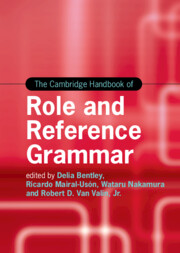Book contents
- The Cambridge Handbook of Role and Reference Grammar
- Cambridge Handbooks in Language and Linguistics
- The Cambridge Handbook of Role and Reference Grammar
- Copyright page
- Dedication
- Contents
- Figures
- Tables
- Contributors
- Pedagogical Guide to The Cambridge Handbook of Role and Reference Grammar
- Introduction
- Part One Overview
- Part Two Topics in RRG: Simple Sentences
- 2 Lexical and Grammatical Categories in RRG
- 3 A Conceptually Oriented Approach to Semantic Composition in RRG
- 4 Semantic Macroroles
- 5 Grammatical Relations
- 6 Argument Structure Alternations
- 7 Case Assignment
- 8 Morphology in RRG
- 9 Adverbs, Mimetics and Ideophones
- 10 Adposition Assignment and Adpositional Phrase Types in RRG
- 11 The RRG Approach to Information Structure
- 12 Information Structure and Argument Linking
- Part Three Topics in RRG: Complex Sentences
- Part Four Applications of RRG
- Part Five Grammatical Sketches
- Index
- References
6 - Argument Structure Alternations
from Part Two - Topics in RRG: Simple Sentences
Published online by Cambridge University Press: 08 June 2023
- The Cambridge Handbook of Role and Reference Grammar
- Cambridge Handbooks in Language and Linguistics
- The Cambridge Handbook of Role and Reference Grammar
- Copyright page
- Dedication
- Contents
- Figures
- Tables
- Contributors
- Pedagogical Guide to The Cambridge Handbook of Role and Reference Grammar
- Introduction
- Part One Overview
- Part Two Topics in RRG: Simple Sentences
- 2 Lexical and Grammatical Categories in RRG
- 3 A Conceptually Oriented Approach to Semantic Composition in RRG
- 4 Semantic Macroroles
- 5 Grammatical Relations
- 6 Argument Structure Alternations
- 7 Case Assignment
- 8 Morphology in RRG
- 9 Adverbs, Mimetics and Ideophones
- 10 Adposition Assignment and Adpositional Phrase Types in RRG
- 11 The RRG Approach to Information Structure
- 12 Information Structure and Argument Linking
- Part Three Topics in RRG: Complex Sentences
- Part Four Applications of RRG
- Part Five Grammatical Sketches
- Index
- References
Summary
This chapter discusses argument structure alternations capitalizing on the Role and Reference Grammar (RRG) notions of logical structure, macrorole and privileged syntactic argument assignment, and linking. A distinction is drawn between lexical and syntactic processes. The lexical alternations (for example, causativization and anticausativization) are often limited in productivity and serve to enrich the lexicon. The syntactic alternations (for example, passivization and antipassivization) are characterized by mappings between the lexical and the syntactic levels, and may play an important role in referent tracking or topic continuity.
Keywords
- Type
- Chapter
- Information
- The Cambridge Handbook of Role and Reference Grammar , pp. 292 - 317Publisher: Cambridge University PressPrint publication year: 2023



